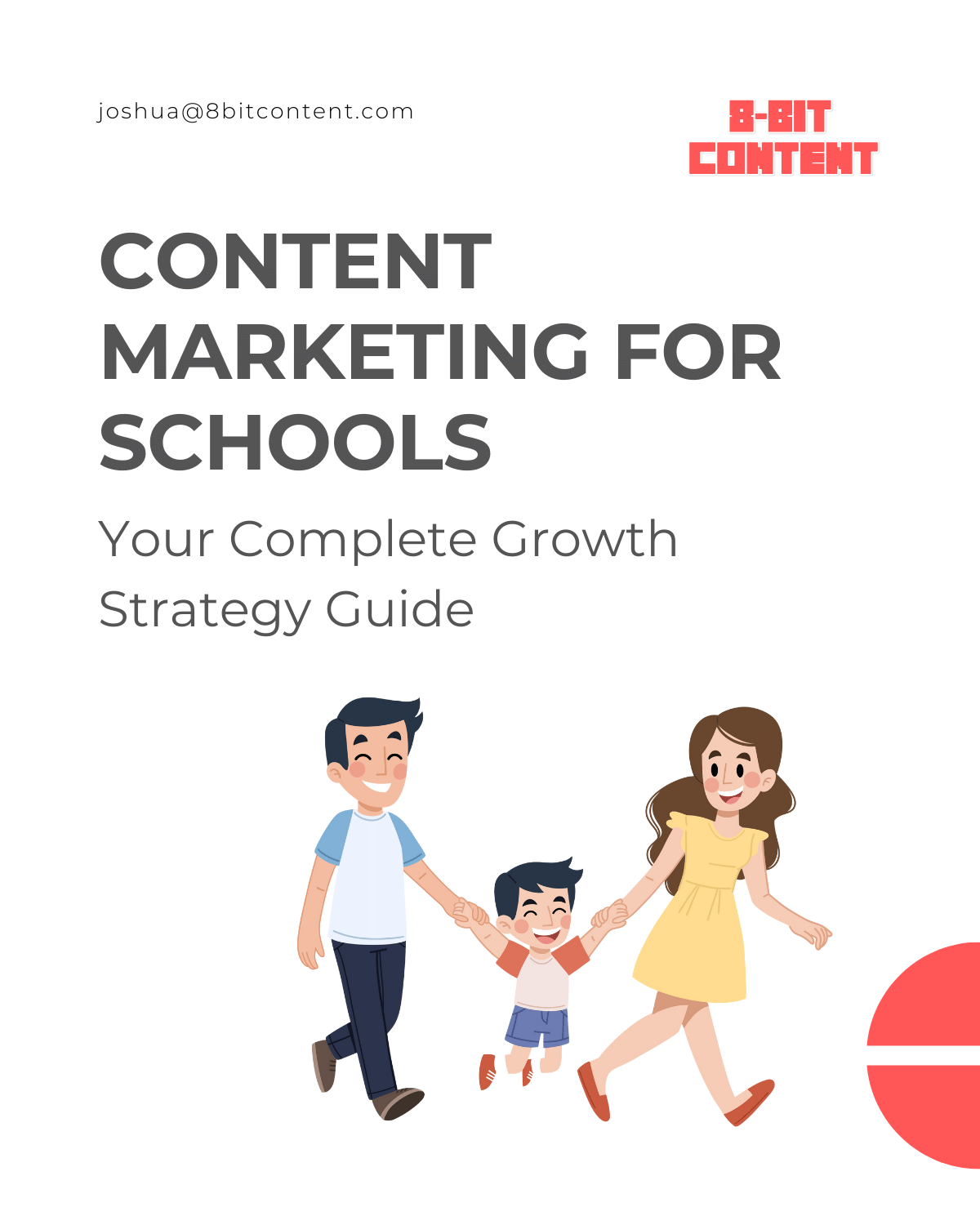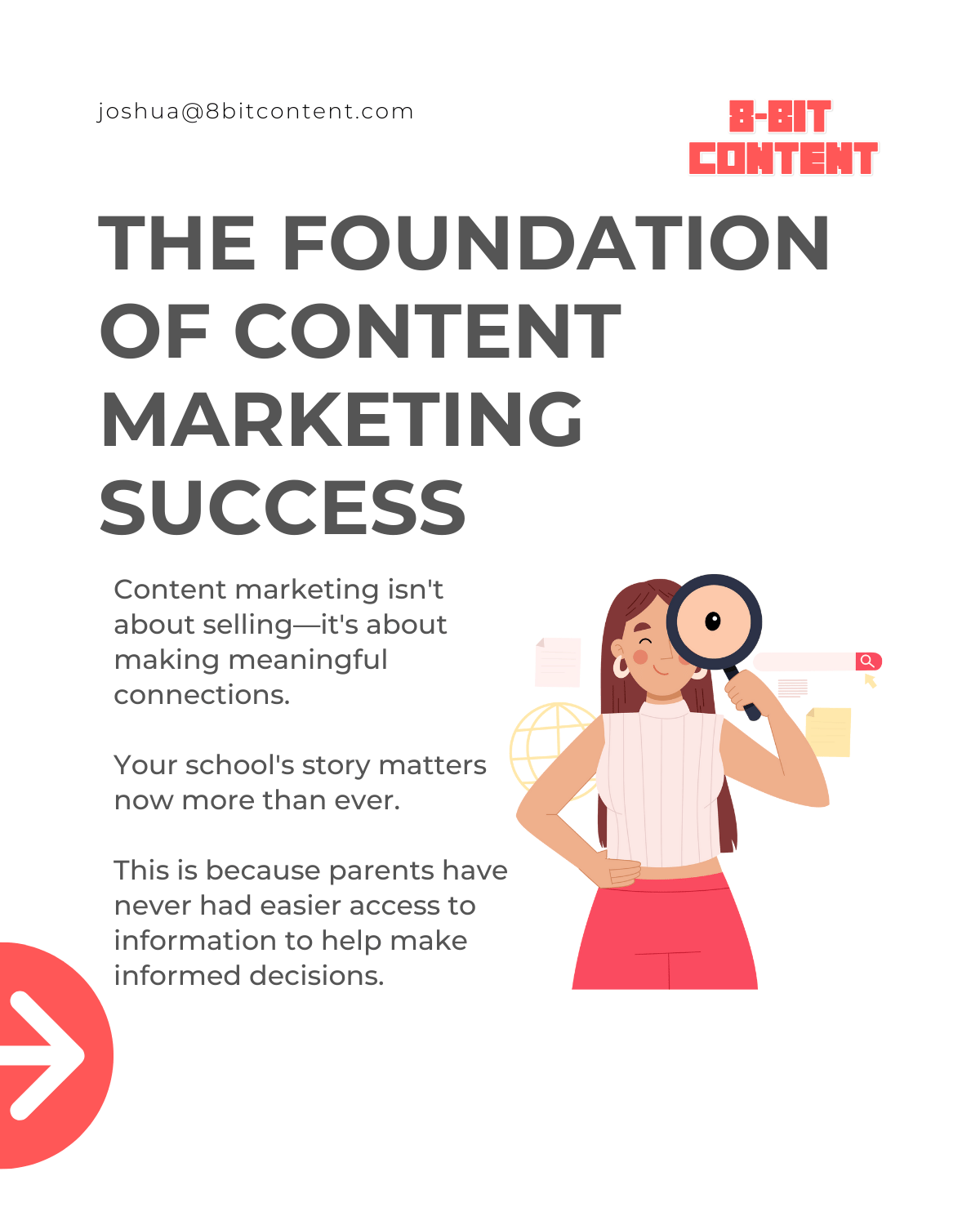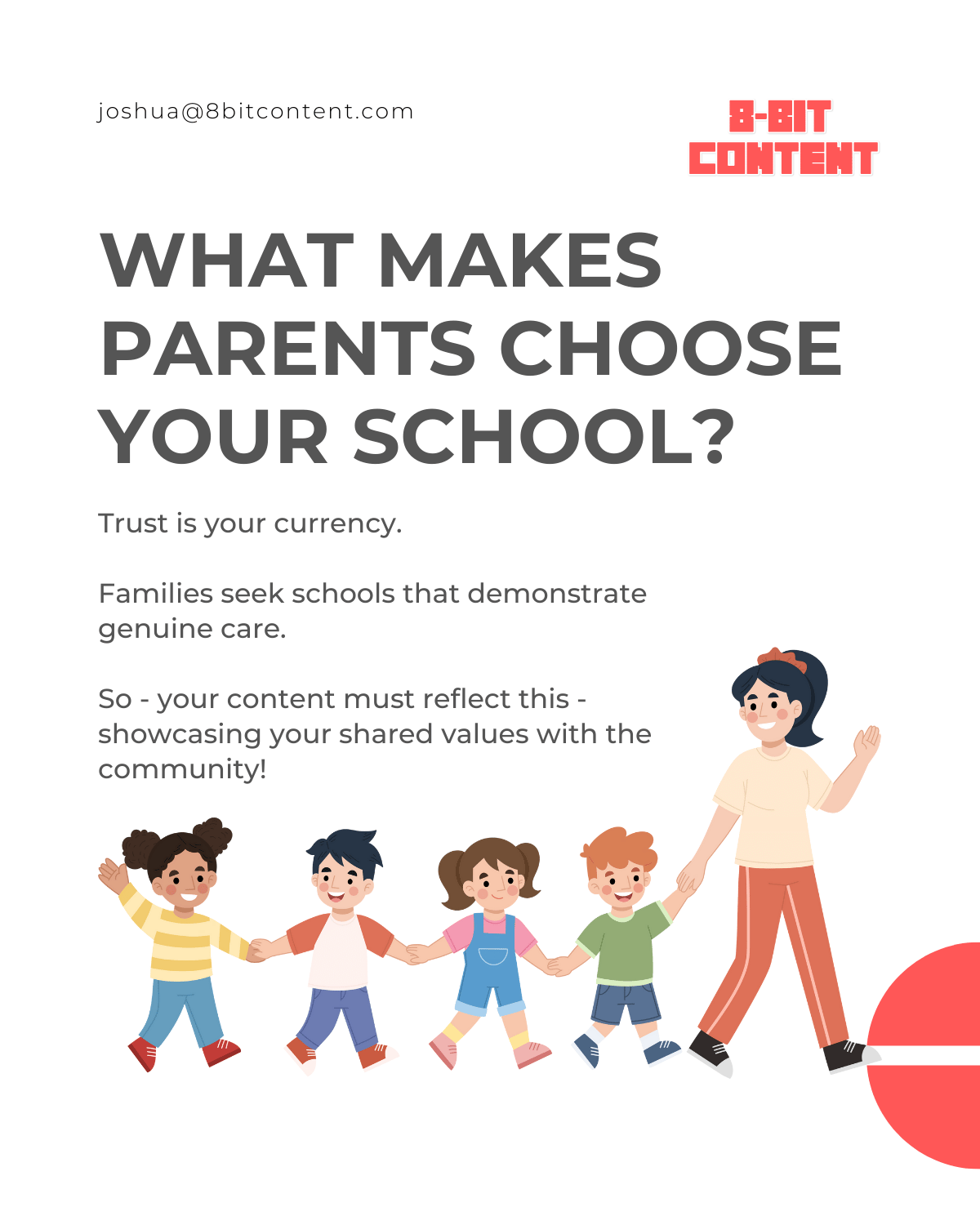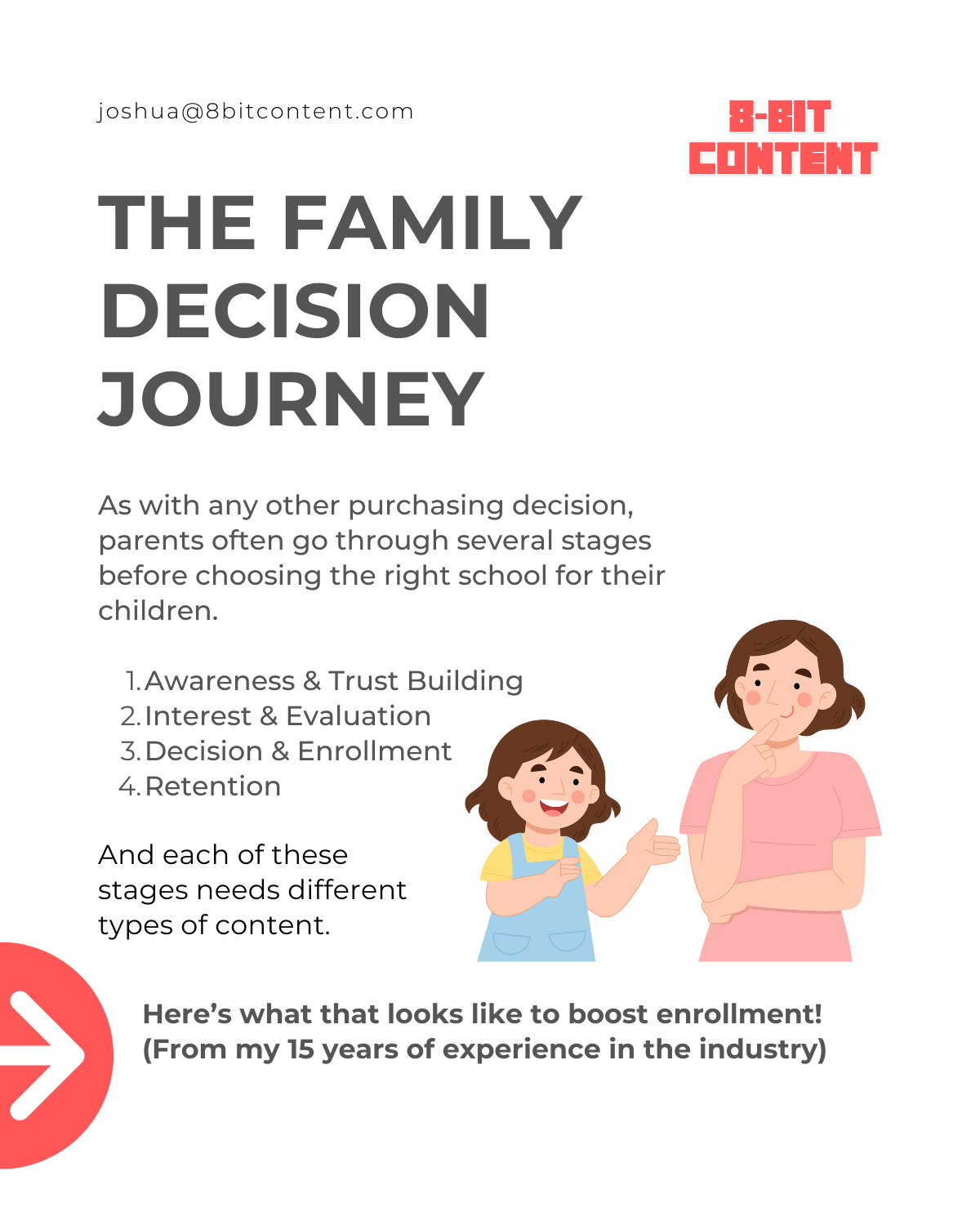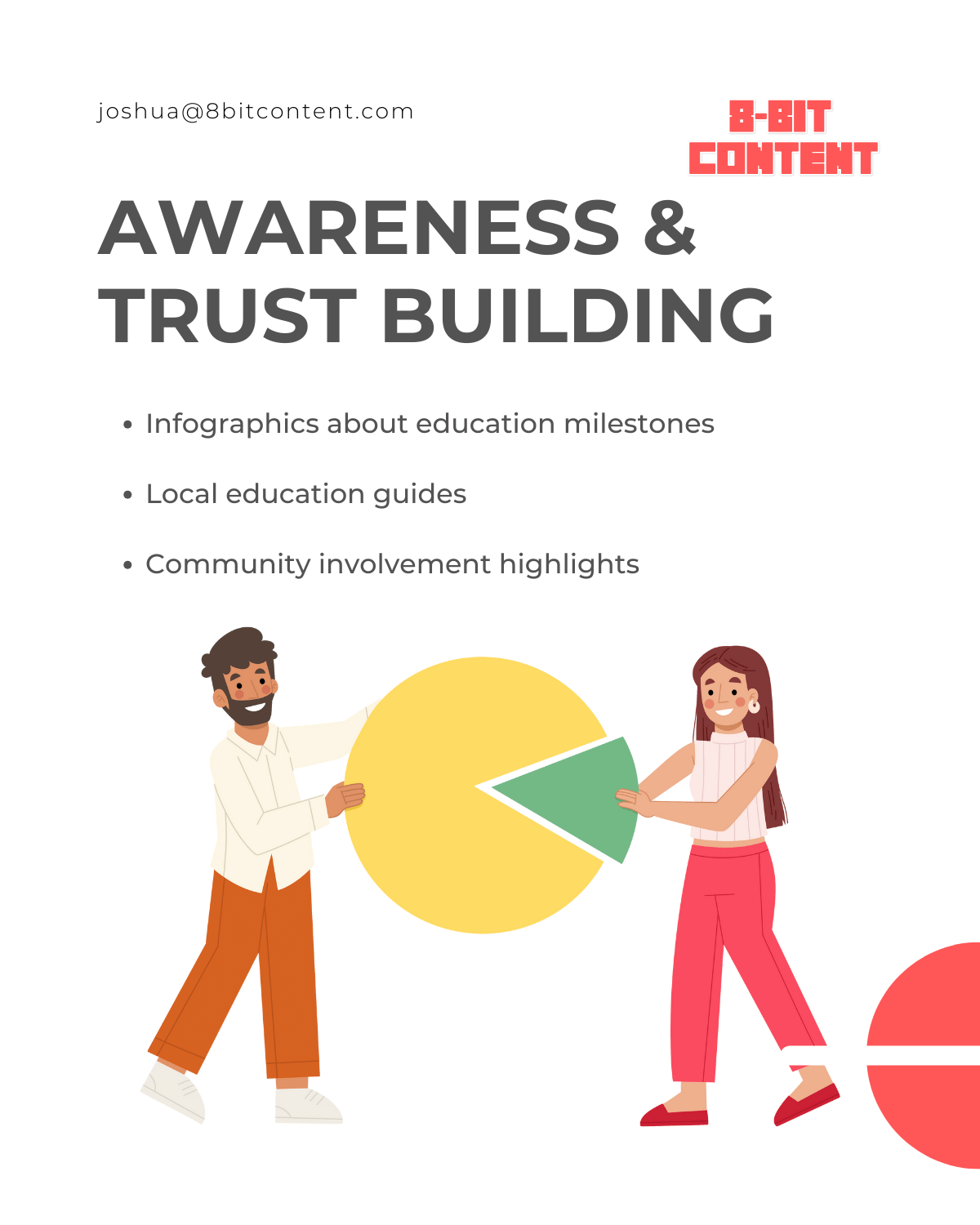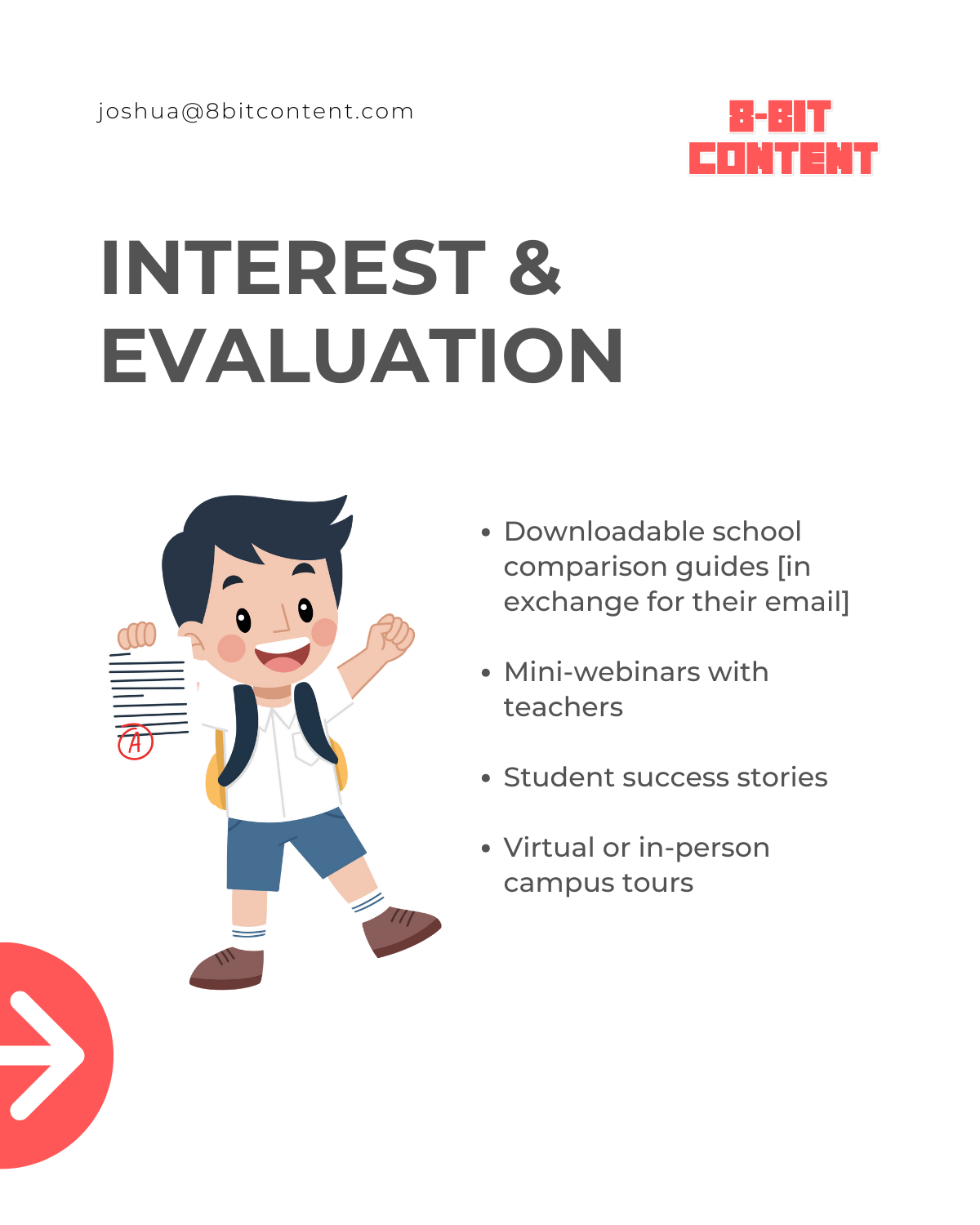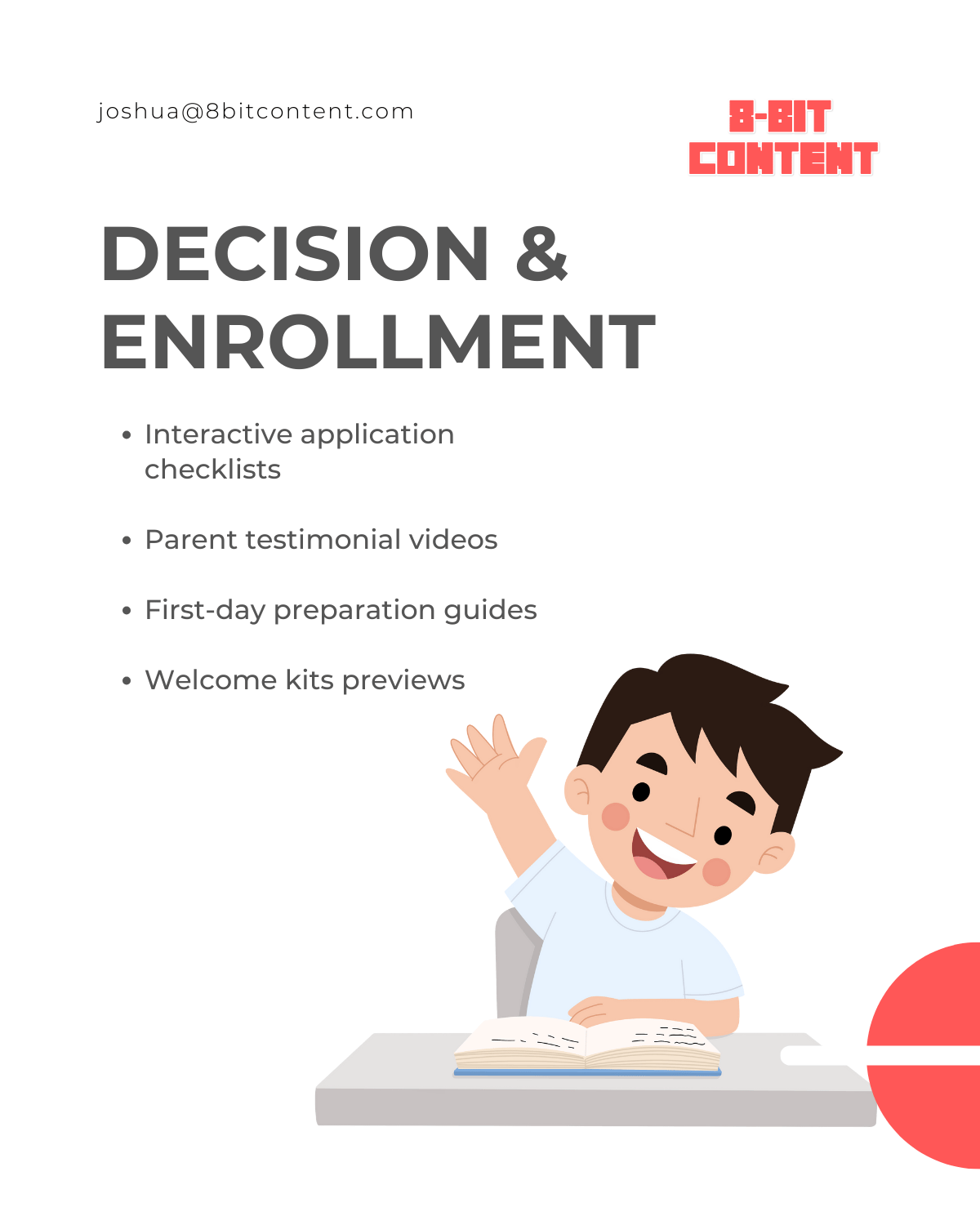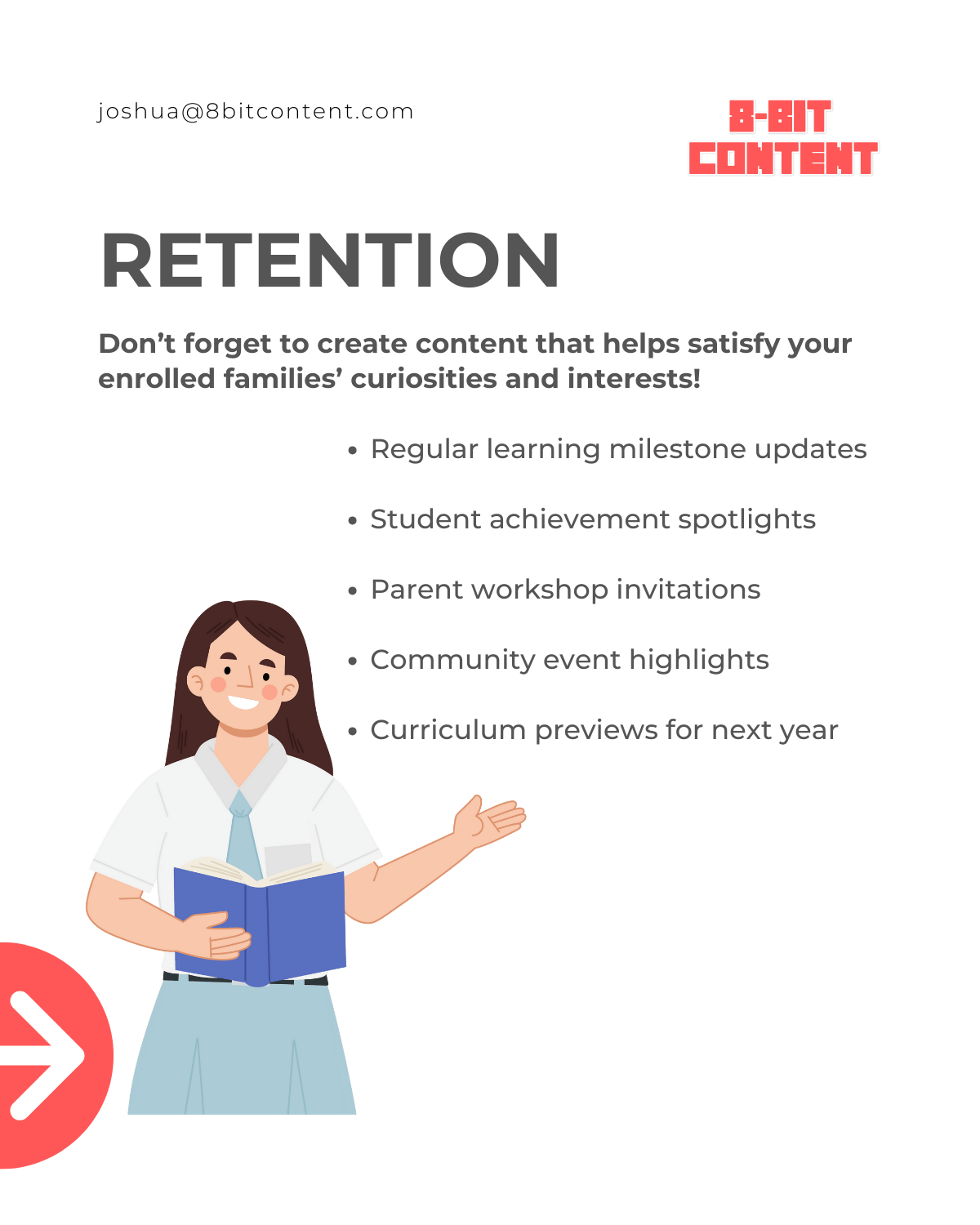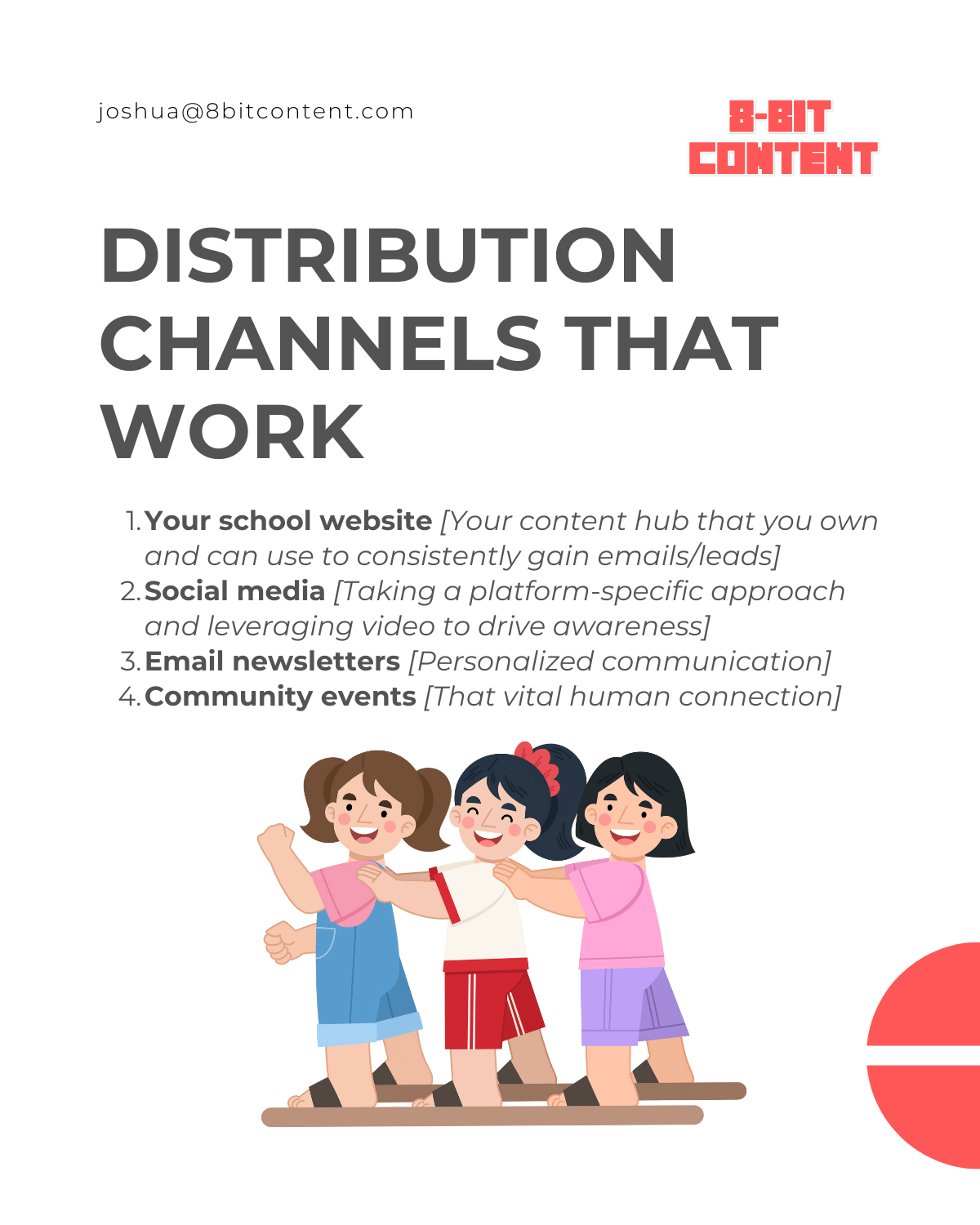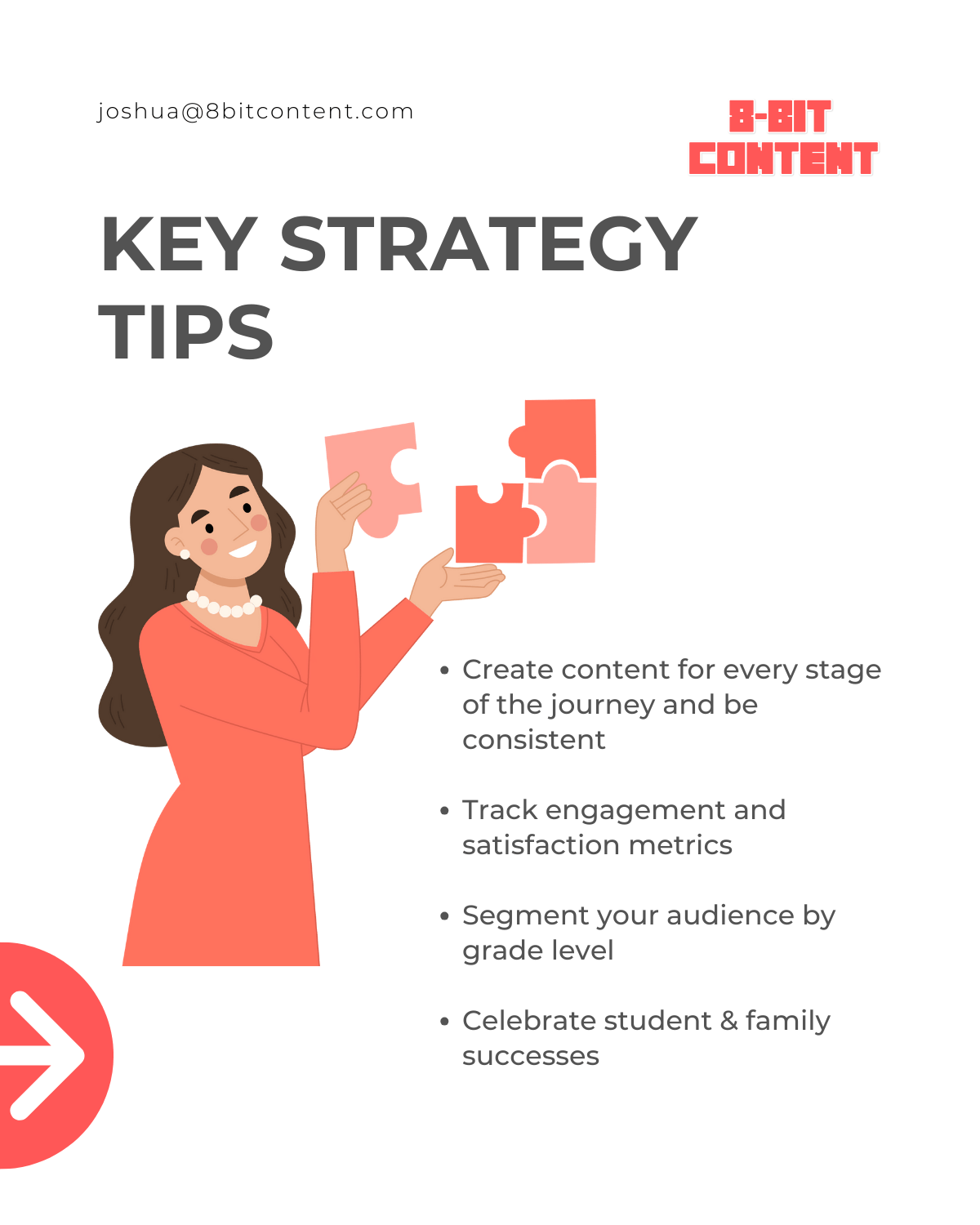Content Marketing for Schools 101: Strategies for Growth
Good content marketing for schools is like that wonderful teacher you always remember.
It's engaging, approachable, and leaves a lasting impression.
When done right, it attracts inquiries, builds trust, and fills the admissions funnel with leads.
I worked in education for over 15 years. Both in a university and as a Managing Director of an international school that grew enrollment year over year, so I know a thing or two.
I also know very well the countless responsibilities school leaders have to juggle. But carving out time to have an effective content marketing strategy is essential.
In this guide, I'm laying out the ABCs of content marketing which every educational and marketing leader needs to know.
Class is in session!

Key Insights on Content Marketing For Schools
Just in case you're in a rush and want the Cliff Notes, here some quick takeaways. I get into greater detail below.
- Strategic Storytelling: Content marketing isn't about selling, but to create meaningful connections. It's your school's opportunity to showcase unique strengths, values, and community through engaging, authentic storytelling that answers families' key questions about your school.
- Family Journey Matters: Choosing a school is an emotional and extremely important decision. And so, your content must guide prospective families through distinct stages—from initial awareness to becoming confident enough to enroll. You can do this easiest by addressing their specific concerns, hopes, and uncertainties at each step of their decision process (ie. sales journey).
- Multi-Channel Approach: Successful school marketing requires an integrated strategy across digital and offline platforms. This means thoughtfully crafting content for websites, social media, emails, and in-person events that maintain consistent messaging of the value your school delivers.
- Data-Driven Refinement: Treat your content strategy like a living document. Use analytics to understand what resonates - which you can then repurpose onto other channels. And of course, track key metrics like inquiry rates and engagement, and continuously adapt your approach to better serve and attract your target families.
- Trust is Your True Currency: Beyond academic achievements, families seek out schools that demonstrate genuine care, transparency, and alignment with their personal values. Every piece of content is an opportunity to build that connection and credibility and show why your school is the right choice.
And in case you prefer more visual content - here are some more ideas we explore in this guide!
What is Content Marketing for Schools?
For many families, few investments matter more than their child's education.
Before choosing a school, families often do extensive online research. And what they find can heavily influence their decision.
Content marketing empowers your school's brand. It helps you shape the narrative and perception families discover during their search.
You can highlight your school’s strengths, values, and achievements. And of course, build awareness through engaging, meaningful content.
This should include:
- Blog posts
- Social media updates
- Email newsletters
- Videos
Families are more likely to choose a school they know, like, and trust.
So, content marketing isn’t about using pushy sales tactics to get them to choose your school in a single visit.
Instead, it focuses on creating and sharing high-quality content that solves problems, answers questions, and builds a real connection.
By showing how your school meets families’ needs, including your unique offerings, success stories, or helpful guides, content marketing helps you be seen as a good choice for the right families.
You can also check out this video for overview of content marketing in general from one of our favourite tools:
Schools produce tons of potentially great content all the time:
- Academic achievements
- Athletic victories
- Art showcases
- Debate competitions
- Family workshops
And somewhere floating in almost every school's cloud is a shared folder full of photos and video clips.
But collecting content is only half the battle. It's what you do with the content that matters.
You need a content marketing strategy.
A strong content marketing strategy for schools answer families’ questions, address their concerns, and showcase what makes your school unique.
And so you must plan how to create and share content that attracts prospective families, engages current students, and builds lasting trust.
It’s about telling your school’s story in a way that resonates and guides families through the journey of choosing a school—from their first impressions to enrolment and retention.
Posting your school's pictures and videos on Facebook, Instagram, and LinkedIn accounts is helpful. But by itself, that's not a strategy. It's a distribution tactic in a broader strategy. (Just be sure to use a video compressor that can maintain quality before uploading. We've seen time and time again - school sites slowed down due to heavy video files.)
A content marketing strategy for schools includes the following components:
- Defined Goals
- Target Audience
- Content Plan
- Distribution Channels
- Content Calendar
- Analytics Framework
And now we’ll look at each in detail.
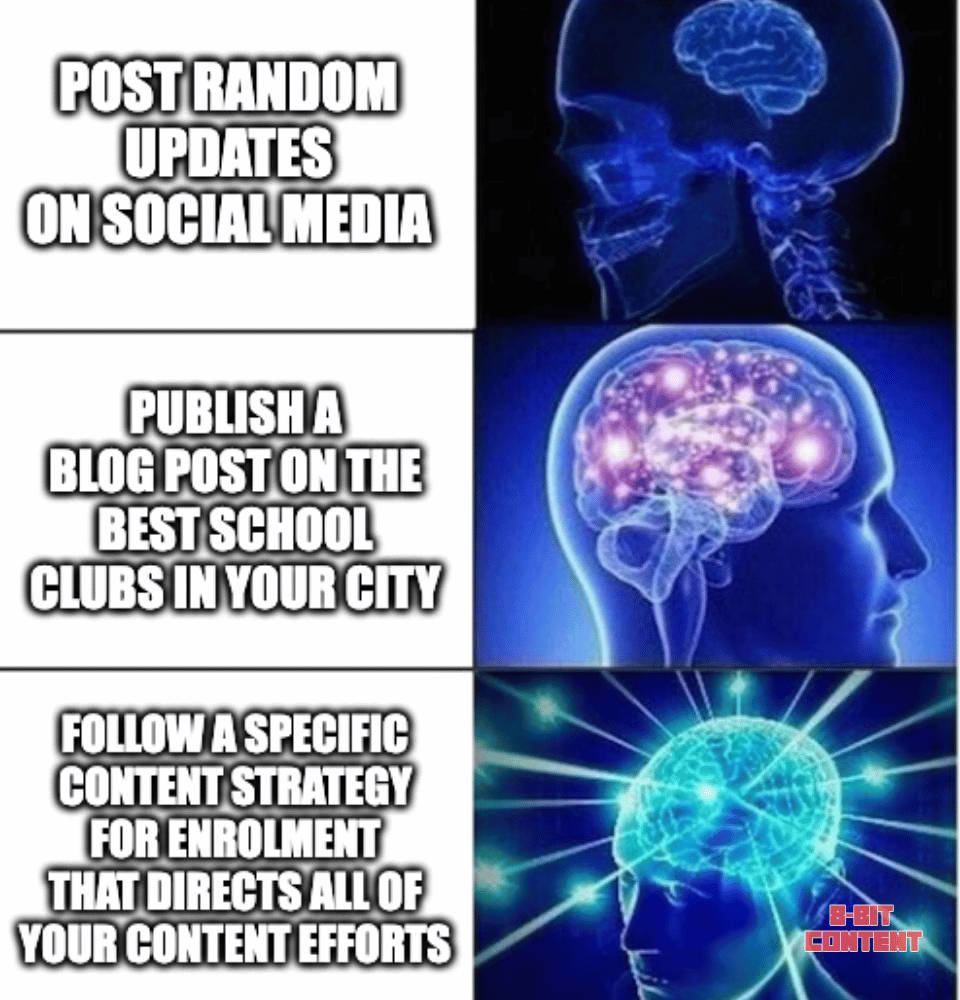
Define Goals for an Educational Content Marketing Strategy
In the big picture, private schools aim to meet recruitment targets to remain financially viable. However, marketing content goals need to be specific and clear.
What are you trying to achieve? More inquiries, higher open house attendance, or stronger community engagement? Likely, it’s all of the above.
To track progress, your goals must also be measurable. This is where the
SMART framework comes in:
- Specific: Define exactly what you want to achieve.
- Measurable: Use metrics like clicks, views, or applications to track progress.
- Achievable: Set realistic targets based on your resources.
- Relevant: Align goals with your school’s priorities.
- Time-Bound: Set deadlines to evaluate success and make adjustments.
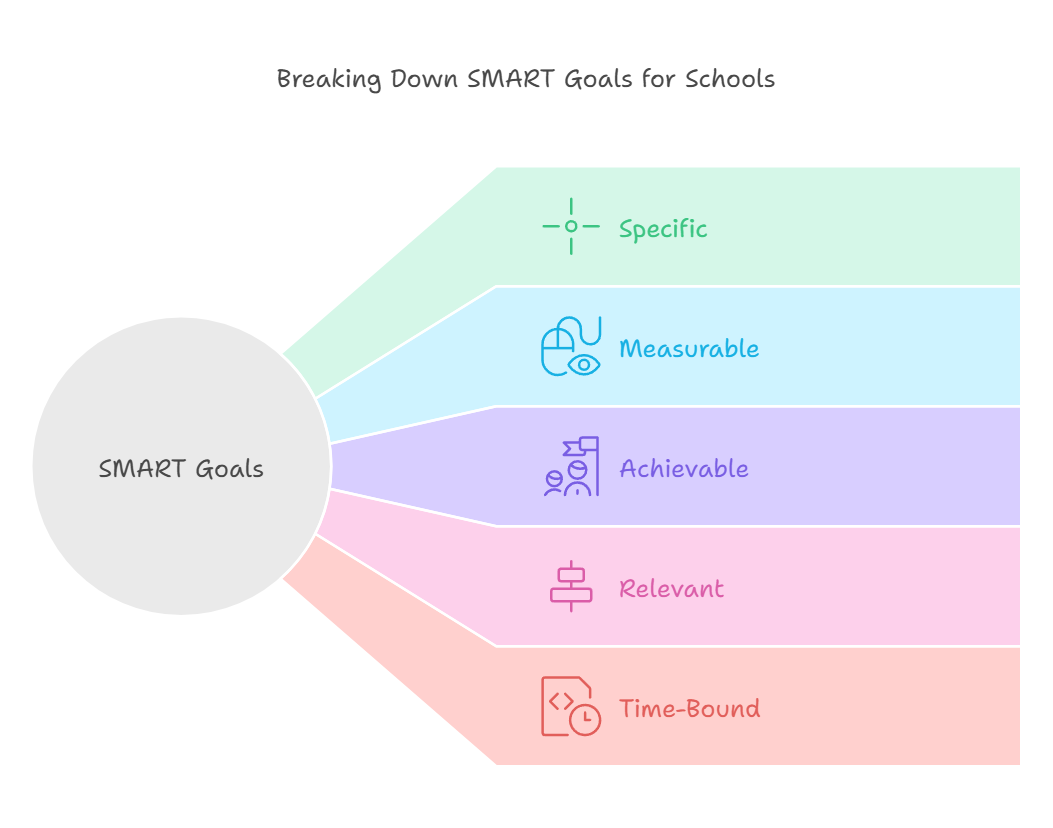
SMART goals can look like this :
- "Increase website inquiries by 20% in six months."
- "Boost open house attendance by 30% for the next event."
- "Reach 10,000 views on the school's promotional video within two months by promoting it on YouTube and through paid Facebook ads."
These well-defined goals provide a clear direction.
And you can use that sense of direction to make sure every blog post, video, or social media update contributes to achieving them.
Understand The Target Audiences of Your Content Marketing Efforts
Similar to how teachers use student-centered approaches - school communication and marketing should be stakeholder-centered.
Your content needs to address the unique needs of prospective families, current families, and even alumni:
- Prospective families. Look for content that highlights academic quality, a safe environment, and opportunities for growth.
- Current families. Want updates that foster connection and keep them informed about events and initiatives.
- Alumni. Value content that maintains their connection to the school and offers ways to engage or contribute.
You also need to consider the different requirements of high school families compared to families with children in elementary school.
As you know, their needs will be very different.
To understand these target audiences, you need to do some research, and segmentation is crucial for creating content that resonates and reflects your school’s mission and values.
Start by analyzing student demographics to identify trends and strengths that set your school apart.
Do families choose you for your STEM programs, arts excellence, or athletic achievements? Are you known for diversity, inclusion, or supporting first-generation students?
I also have always liked to make use of the school's mission and vision to help guide type of content we create and share.
If your school's mission emphasizes personal excellence, global understanding, or curiosity, then you should also be actively attracting families who care about these values.
You will want to enroll families who are aligned your school values. If families feel connected to values you demonstrate, it will help with retention.
Key Steps to Understanding Your Audience
| Step | Details |
|---|---|
| Conduct Surveys | Gather feedback from prospective parents, current families, and alumni to learn what they value most. |
| Analyze Data | Use enrollment records, event attendance, and engagement metrics to identify patterns in demographics and interests. |
| Develop Audience Profiles | Create profiles that highlight key traits, needs, and challenges for each stakeholder group |
| Tailor Content Topics | Align your content themes with audience priorities, like student achievements for parents or alumni stories for graduates. |
| Leverage Tools | Use analytics platforms like Google Analytics, social media insights, or email marketing tools to track audience engagement and refine your approach. |
| Test and Adapt | Regularly evaluate the performance of your content and adjust based on what resonates with each audience segment. |
Create a Content Plan
When families begin searching for the perfect school, their journey is full of questions, hopes, and uncertainties.
A well-crafted content plan can help and guide them along the journey.
In this section, we’ll show how matching your content to what families need at each stage of their decision-making process, from discovery to enrollment, can turn prospective families into part of your school community.
The Starting Point: Awareness in Content Marketing for Schools
At the start of their journey, potential students and families may not even know your school exists.
And they can't choose you if they don't know you. So, your first goal has to be getting your school on people's radar.
Your awareness strategy should include content like blogs, social media posts, and videos that introduce prospective students and their families to your programs, values, and community. And be sure to check out my mega-guide to SEO for higher education for more ideas.
I found that becoming an active member of various Chambers of Commerce could also be effective in getting my school known. I was often even able to distribute some content to the chamber members which helped spread awareness to potential parents.
So at the awareness stage, you're aiming to spark curiosity and draw prospective parents and kids into what you have to offer.
Ideas for this can include:
- Infographics: such as "The Key Milestones in Early Education," can establish your school as a knowledgeable and supportive resource for parents.
- Localized Blog Posts: Articles like "A Parent’s Guide to Choosing the Best Private School in [Your City]" with practical tips for evaluating private schools, using your school’s programs and values as examples. Learn more about how to get your blog noticed in our full guide.
- Community Spotlights: Highlight partnerships, local involvement, or alumni giving back to the area to showcase your school’s connection to the community.
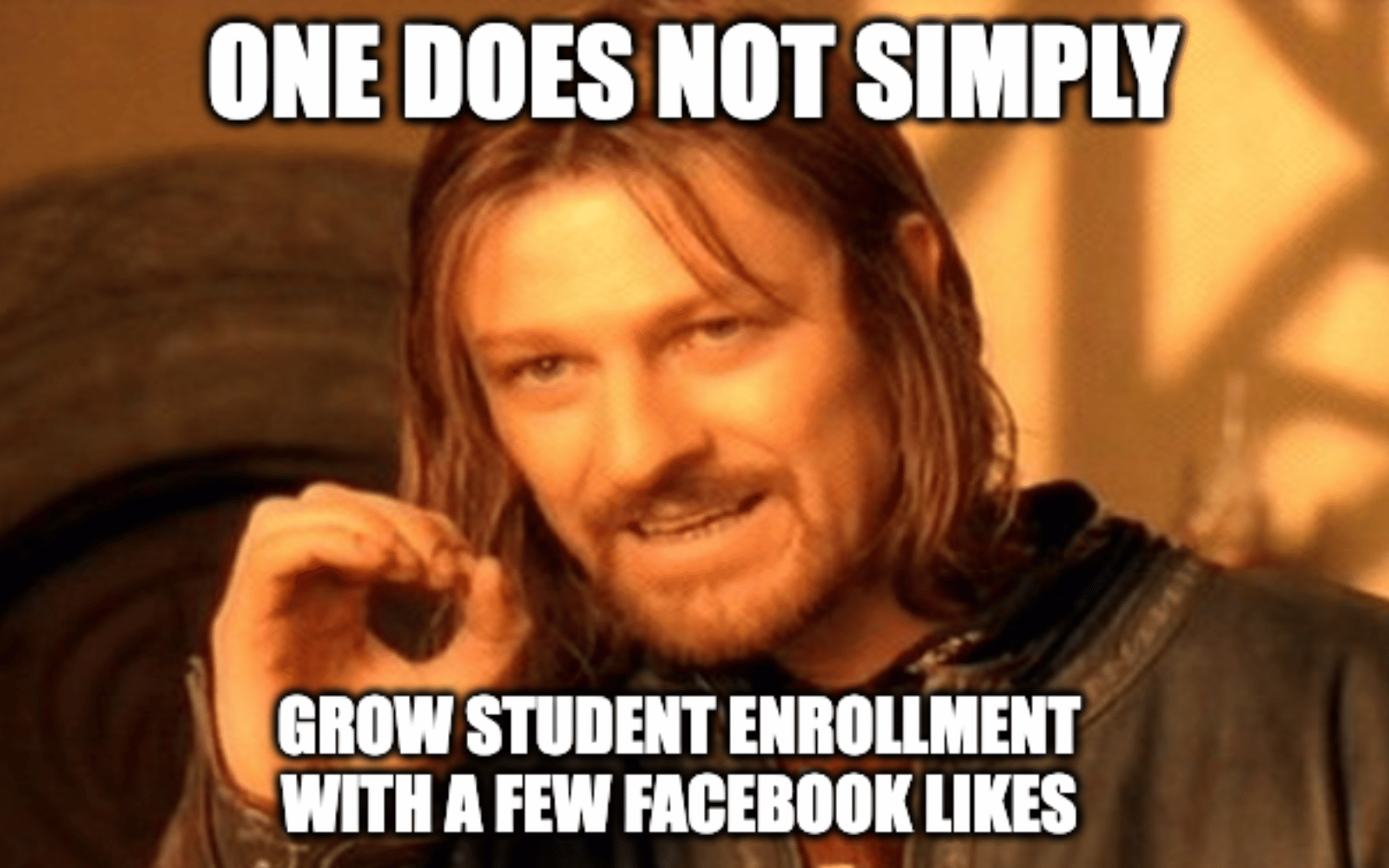
Attract Prospective Families
Even after a family knows you exist, they're still going to be weighing their options.
And as families explore the landscape of possible schools, you need to give them some good reasons to consider your school.
To do that, you're going to need a healthy supply of compelling content that answers a potential family's initial frequently asked questions.
- Parent Guides: Downloadable guides like "How to Choose the Best School for Your Child" explaining key considerations and mention your school’s unique strengths.
- Mini-Webinars: Sessions hosted by teachers, school leaders or alumni, such as "Benefits of Bilingual Education," or "How to get your kids to love reading."
- Comparison Checklists: Offer tools like "Questions to Ask on Your School Tours" to help families see why your school stands out.
Bottom line: you need content that piques their interest and encourages them to want to get to know you better.
Build Trust and Credibility

If you've been in the shoes of a parent choosing a school, you know the journey is not particularly fun. In fact it is time-consuming and can quickly become overwhelming.
Your content for this stage needs to reassure them that they’re moving in the right direction.
To do this, you need to reinforce credibility and affirm that your school is a reliable, high-quality choice.
- Success Stories: Feature detailed profiles of students or alumni excelling in academics, sports, or community service.
- Awards Highlights: Showcase any local, national, or international recognition your school or students have received.
- Staff Profiles: Short personal videos or blog posts introducing teachers and their expertise.
- Staff Profiles: Short personal videos or blog posts introducing teachers and their expertise.
- Student-Generated Content: Creative work from students, like essays, artwork, or science fair projects, to illustrate your school’s nurturing environment.
E-books of student work can be a great way to accomplish this.
Engage and Nurture Leads: Helping Them Navigate
Families in this stage have moved beyond surface-level research.
Now, they are now evaluating your school on specific criteria, comparing it with competitors, and weighing practical considerations like values alignment, academic offerings, and community fit.
To truly engage and nurture them, your content must anticipate their deeper questions and deliver nuanced, personalized insights that foster a strong sense of insight and alignment.
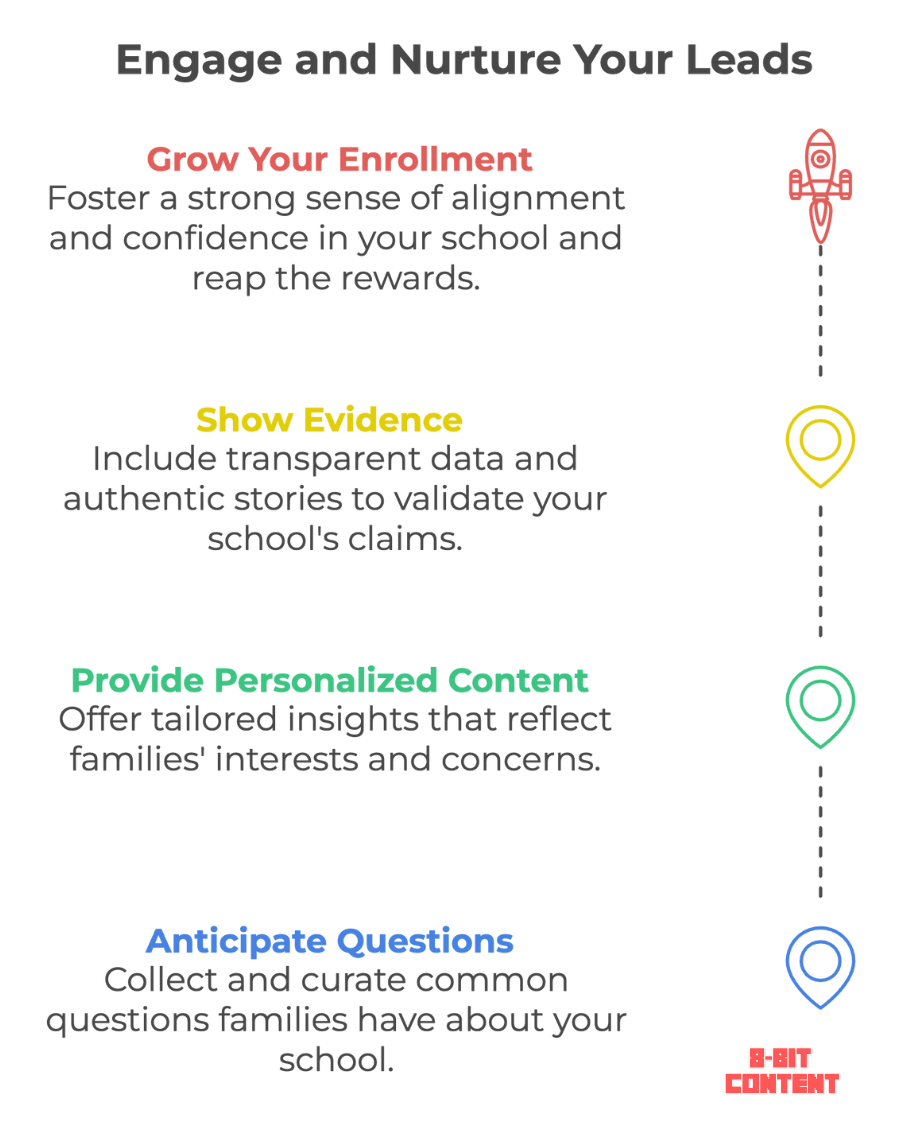
Don't Give Them Generic Content:
Virtual tours and newsletters are foundational now, but this stage demands content that reflects families’ unique needs.
For instance, if families show interest in your arts programs, make sure you can share exclusive content like interviews with families on their previous experiences with your programs.
And also faculty and student achievements in the arts, or upcoming arts-related events.
Show, Don’t Just Tell:
Families are seeking evidence that your school lives up to its promises. Instead of describing your values, show them in action.
How? You can do this by sharing transparent data: examination results, university admissions success rates, or athletic achievements.
If your school claims to contribute to the community, then show evidence that your school does this.
You can supplement this with authentic storytelling like videos or blogs from students and parents that reflect lived experiences rather than rehearsed testimonials.
Think Like a Problem-Solver:
At this stage, families want to eliminate risk and uncertainty.
Help them do that.
Build content that pre-emptively answers questions they might not know to ask yet:
- What happens if my child struggles academically?
- How does the school support new families in adjusting to the community?
- Anticipate these hesitations with clear, actionable answers in your messaging.
The key to success in this stage is treating every interaction as a chance to build a bridge of trust.
When families feel seen, understood, and valued, they are far more likely to choose your school with confidence.
Decision Stage: Removing Barriers to Enrollment
Now families are seeking validation that your school is the right choice.
Your approach has to beyond just answering logistical questions.
To do this, create resources that feel personal and intentional, and that reinforce confidence and simplify the enrollment process.
Straightforward strategies like printed materials or easily created multimedia can convey warmth and attention to detail by addressing the most common concerns families face—such as values alignment, and future outcomes.
Interactive Application Checklist: A digital tool families can personalize to track their progress through the enrollment process.
Enrollment Story Features: Share stories of other families’ decision journeys in a newsletter or blog to help prospective parents see themselves in your community.
Print-Friendly FAQs: A downloadable or printable FAQ document with clear, visually engaging answers to common questions like tuition, schedules, and transportation.

Enrollment: Turning Commitments Into Connections
Congratulations. Your school has successfully enrolled another wonderful student to join your vibrant community.
But don't celebrate just yet. From the day they start, you need to start the effort to retain that student and family.
This is where trust is either solidified or shaken.
Make sure you map out a seamless onboarding experience to set the tone for their relationship with your school.
Everyone does welcome emails, but you have the chance to go the extra mile by creating an onboarding journey that feels personal.
Examples to Elevate Your Onboarding Process:
- Personalized Video Messages: Send a welcome video from the principal or the child's homeroom teacher, addressing the new student's name and grade.
- First-Day Success Kits: Provide students with school-branded items and parents with a checklist to ensure a smooth transition.
- Peer Ambassadors: Pair new students with current ones to answer questions and provide a friendly face on day one. Give those ambassadors recognition and awards for their contribution and reinforce a culture where students recognize they are vital partners in building a great school.
Most schools do some of these steps, but very few do all.
So, taking the time and making the effort to have a content plan for every of the family's decision-making journey will be worth it.
How you do anything is how do everything. Your school's content plan should reflect the same level of excellence that you expect in your teaching and learning.

Distribution Channels for Your School's Content Marketing Strategy: Beyond the Basics
Choosing where to share your content is only the beginning. To maximize the impact of your efforts, it’s essential to go deeper into how each channel can be leveraged strategically.
All Roads Should Lead To Your Website
Don't make the mistake of thinking that your school website is just a virtual brochure.
It should be the backbone for all your marketing efforts.
Every other channel should drive traffic back to your site. And on your site families should be able to find up-to-date comprehensive information, explore your programs, and take action.
- Optimize for Mobile: With most searches now happening on mobile devices, your website must offer a seamless experience across all screen sizes. A slow-loading or clunky mobile site turns away prospective families before they even explore your content.
- Landing Pages for Specific Goals: Dedicated landing pages for open houses, specific programs, or admissions inquiries are key. These pages need tailored content with strong copywriting and clear calls-to-action (CTAs) to get families emails and begin their sales journey.
- SEO-Driven Content: A blog post isn't a tick in a box. Blogs and other web pages must be optimized for search engines. You need to know and use the relevant topics, and include on-page best practices, and internal linking. This can be time-consuming and labor-intensive, but it makes it easier for families to find your school when doing their online research. And schools can also improve these efforts by working with high quality link building specialists like Create & Grow to help turn well-planned content into sustainable organic traffic and more qualified enrollment inquiries over time.
At 8-Bit, we excel at providing our clients with both the consultation and the heavy lifting for everything related to website content marketing strategy.
We've even grown a site by 1200% to achieve 1 million page views in a single month (granted - not for a school).
But if you're curious, get in touch to see how we can help you.
Social Media: More Than Just a Megaphone
Facebook, Instagram, YouTube, and even LinkedIn are essential tools for amplifying your school’s message.
But success lies in how you use these platforms, not just that you use them.
- Platform-Specific Content: Tailor your posts to fit each platform. Instagram thrives on visual content like student spotlights, behind-the-scenes glimpses, and event highlights. LinkedIn is better suited for thought leadership and alumni success stories.
- Engagement Strategies: Social media isn’t a one-way street. Respond to comments, share user-generated content, create polls or Q&A sessions to foster genuine interaction. And don't forget to encourage people to share to help broaden your reach.
- Paid Campaigns: Organic content gets more trust, but its reach only goes so far. Boost important posts or run targeted ad campaigns to reach prospective families in your area. Platforms like Facebook allow you to target ads by location, interests, and demographics.
Email Newsletters: Personalized Communication at Scale
When done correctly, email is one of the most effective tools for nurturing leads and keeping current families engaged.
BUT WAIT!
Ever hear the joke about the parent who quits their job so they can dedicate their time to reading emails from their kid's school?
You dont wan't to be that school and you don't want to be that school before they even enroll their child.
Parents also don't want to get buried by emails from their child's school. There is such a thing as too much email.
Here's what to know when it comes to using email effectively:
- Segmentation: Divide your email list into groups like prospective families, current parents, and alumni. Each group should receive content tailored to their interests and needs.
- Drip Campaigns: Automate a series of emails to guide prospective families through the admissions funnel. For example, send an introductory email, followed by a testimonial video, and finally, a reminder to RSVP for your next open house.
- Rich Media: Make emails visually appealing by including embedded videos, infographics, or downloadable guides. This helps keep readers engaged and encourages them to click through to your website.
At 8-Bit we have a strong track record getting people to actually open and read emails. And speaking of Email, send us one, or fill in our contact form to see how we can help you leverage email to boost your enrollment!
Offline Opportunities: Building Human Connections
While digital channels are powerful, don’t underestimate the importance of face-to-face engagement.
- Community Events: Partner with local organizations to host events that align with your school’s values. Whether it’s a STEM fair, a cultural festival, or a charity run, these events build goodwill and brand awareness.
- Print Materials with QR Codes: Brochures, flyers, and posters can still play a role in your strategy. Add QR codes that direct families to specific landing pages, making it easy for them to engage further.
- Open Houses: Enhance your open houses by integrating digital tools. For instance, use an app to guide families through the event or provide digital follow-up materials post-visit.
And looking at your website's analytics can give you some great insights about what topics parents and students care about. If the data tells you that a lot of prospective parents visit and spend time reading the page on your website about the swimming program, for example, then organize an event with your swim team about this topic.

Integrate Channels for Maximum Impact
They say “it takes a village” to educate a child. The process requires love, support, partnership, and collaboration from multiple members of the community.
When it comes to marketing a school, it takes an ecosystem. And the integration of distribution channels is key.
Each channel should collaborate seamlessly to guide families through their decision-making journey and build trust at every stage.
- Cross-Promote Content: Share blog posts or videos across social media platforms, link to them in your email newsletters, and mention them during events. Each channel should amplify the others.
- Retargeting Campaigns: Use tools like Google Ads or Facebook Pixel to retarget families who visit your website but don’t take action. Show them ads reminding them of open houses, key deadlines, or standout programs.
- Track and Adjust: Use analytics to measure the performance of each channel. Identify which platforms drive the most engagement and refine your strategy accordingly.
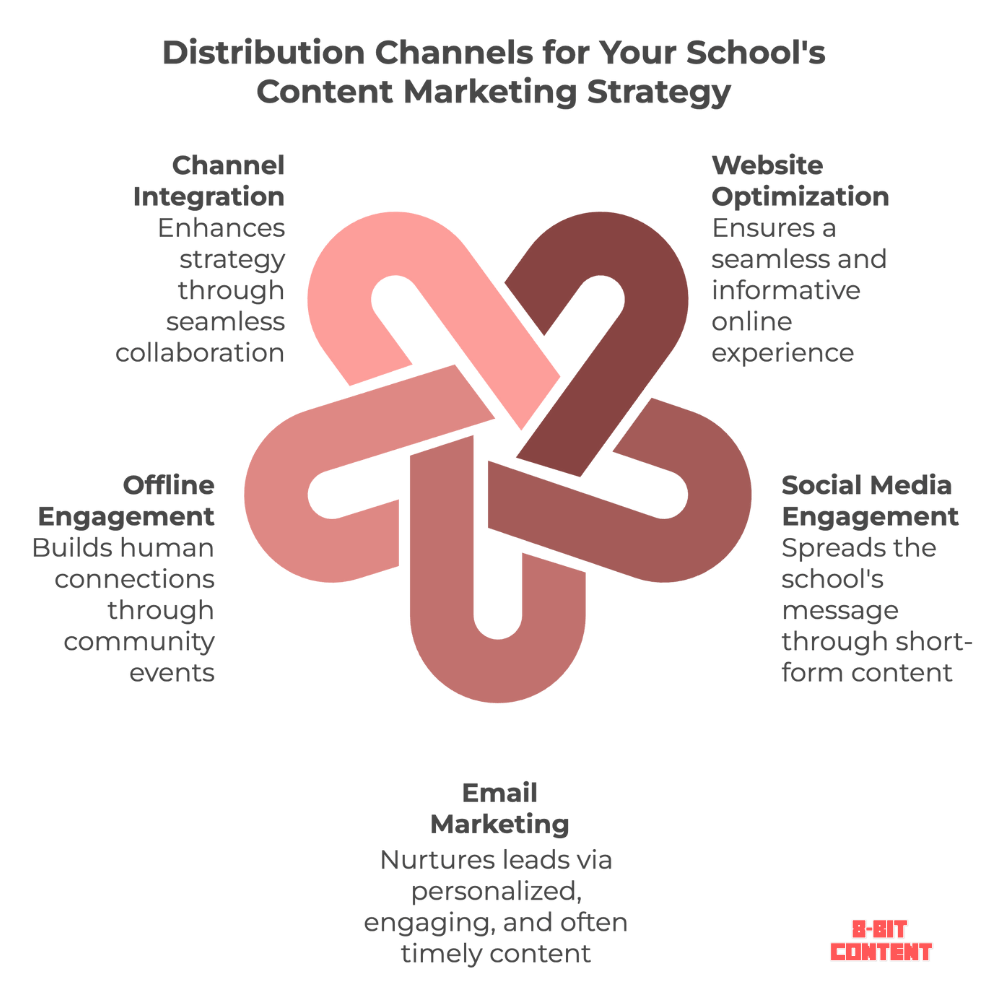
Content Calendar for Schools: Steady and Strategic Wins the Race
When it comes to a content calendar, the most important thing you need to know is this: consistency is key.
Who won the race between the tortoise and the hare? Not the flash-in-the-pan hare. It was the steady and consistent tortoise.
And while you can't afford to be slow, you do need to be steady and strategic. Consistency keeps you in the race, but strategy helps you win it.
Align Your Content with Key School Milestones
Your calendar should work with the rhythm of the academic year and align with what families care about most at any given time.
- Admissions Deadlines: Plan posts, emails, and reminders well in advance of critical admissions dates. Highlight open house events, application tips, and testimonials from current parents to guide families through the process.
- Seasonal Themes: Use moments like back-to-school, graduation, or holidays to create relatable, engaging content. For example, share a post on “5 Ways to Help Your Child Prepare for the First Day.”
- Program Spotlights: Dedicate slots to showcasing what makes your school unique—STEM programs, performing arts, or sports achievements. A short video tour or student spotlight can go a long way.
Align Your Content with Key School Milestones
Your calendar should work with the rhythm of the academic year and align with what families care about most at any given time.
- Admissions Deadlines: Plan posts, emails, and reminders well in advance of critical admissions dates. Highlight open house events, application tips, and testimonials from current parents to guide families through the process.
- Seasonal Themes: Use moments like back-to-school, graduation, or holidays to create relatable, engaging content. For example, share a post on “5 Ways to Help Your Child Prepare for the First Day.”
- Program Spotlights: Dedicate slots to showcasing what makes your school unique—STEM programs, performing arts, or sports achievements. A short video tour or student spotlight can go a long way.
Use Analytics Frameworks For School Marketing
Educators and marketers often share a love for data.
Like any good teacher worth their weight in gold, effective marketers track metrics to find trends to act on.
A good framework will point out insights, match content with enrollment goals, and highlight the necessary optimizations to improve your strategy.
To do this, you need to identify and track the key metrics that matter most at each stage of the family journey.
For example, how many families click from blog posts to admissions pages? Or how often are virtual tours viewed by geography?
These insights should be used to tailor your content distribution and target prospective families where they are most active.
Advanced Yet Accessible Analytics Ideas:
Heatmap Tools: Use simple heatmap software (e.g., Hotjar) to see where families click on your site, identifying user behaviour that informs design and content changes.
Content Gap Analysis: Use analytics to uncover topics your audience searches for but that your site doesn’t yet address, then create targeted blog posts or videos.
Attribution Mapping: Build a framework to track which content types (blogs, videos, social posts) lead families closer to inquiries or enrollment, refining future efforts.
By going beyond basic tracking and incorporating strategic insights, your analytics framework becomes a guide for maximizing the impact of your content marketing efforts.
Final Say on Content Marketing for Schools
Effective content marketing for schools isn’t about quick wins; it’s about building trust, answering questions, and creating meaningful connections.
To succeed, you need to align your strategy with the family journey.
School selection is something that matters on a deeply emotional level because the stakes are high and people want the best for their kids.
With a thoughtful approach and consistent execution, you can drive engagement, boost enrollment, and strengthen your school community.
And we can help. In fact, we would love to help you.
Blog
Let’s grow your online visibility together!
Join our newsletter for actionable tips and checklists!
Contact Us
You can also find us here:

